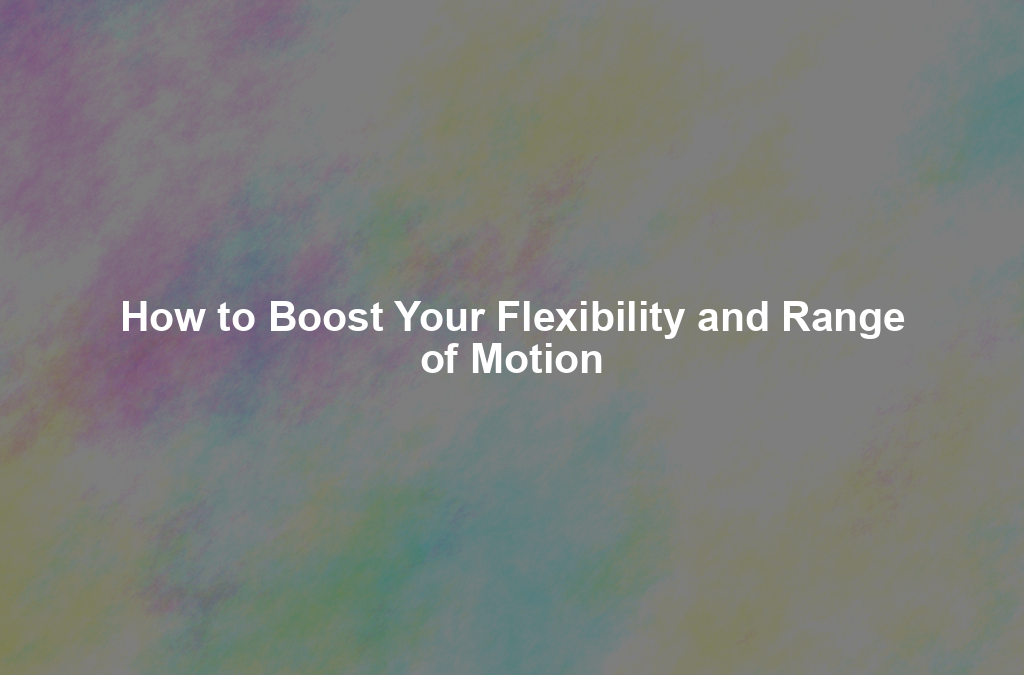
How to Boost Your Flexibility and Range of Motion

Flexibility and range of motion are key components of physical health. Flexibility refers to the ability of your muscles and joints to move through their full range. This capability plays a crucial role in maintaining overall health. Improved flexibility can enhance athletic performance, reduce injury risks, and boost quality of life. Engaging in activities like yoga can increase flexibility by up to 35% in just eight weeks. The Mobility Revolution: Techniques for Increased Flexibility and Range of Motion offers practical ways to achieve these benefits. Embrace flexibility exercises to enjoy a healthier, more active lifestyle.
Understanding Flexibility and Range of Motion
What is Flexibility?
Definition and Importance
Flexibility refers to the ability of your muscles and joints to move through their full range. This capability plays a crucial role in maintaining overall health. Improved flexibility can enhance athletic performance, reduce injury risks, and boost quality of life. Engaging in activities like yoga can increase flexibility by up to 35% in just eight weeks.
Types of Flexibility
Flexibility comes in different forms. Static flexibility involves holding a stretch without movement. Dynamic flexibility involves moving parts of your body through a full range of motion. Both types contribute to overall physical fitness. The American College of Sports Medicine recommends stretching exercises at least two days per week for healthy adults.
What is Range of Motion?
Definition and Importance
Range of motion (ROM) describes how far you can move a joint in different directions. A good ROM allows you to perform daily activities with ease. Improved ROM can prevent injuries and enhance physical performance. Flexibility training interventions often increase joint ROM in various joints.
Factors Affecting Range of Motion
Several factors influence your ROM. Age can limit how much you can move your joints. Muscle strength and flexibility also play a role. Injuries or medical conditions may restrict movement. Regular exercise and stretching can help maintain or improve your ROM. Using light weights through the full range of motion promotes better flexibility.
Benefits of Improved Flexibility
Physical Health Benefits
Injury Prevention
Flexibility exercises help keep muscles and joints limber. This limberness reduces the risk of injuries during physical activities. Stretching and calisthenics, for example, can decrease the risk of developing functional limitations as you age. Regular flexibility training also enhances balance performance. Enhanced balance lowers the chances of falls and related injuries.
Enhanced Performance
Improved flexibility boosts athletic performance. Athletes often perform better when their muscles move freely. Flexibility increases the range of possibilities for work, play, and self-expression. Sports like gymnastics, dance, and martial arts require high levels of flexibility. Even in everyday activities, enhanced flexibility allows for smoother and more efficient movements.
Mental Health Benefits
Stress Reduction
Flexibility exercises contribute to stress reduction. Stretching releases tension stored in muscles. This release promotes relaxation and a sense of calm. Activities like yoga incorporate deep breathing and mindfulness. These practices further aid in reducing stress levels. A flexible body often leads to a more relaxed mind.
Improved Sleep
Better flexibility can lead to improved sleep quality. Stretching before bed helps relax the body. Relaxation prepares the body for restful sleep. Yoga poses, in particular, encourage deep breathing and relaxation. This practice can enhance the ability to fall asleep faster and enjoy deeper sleep. A good night’s sleep contributes to overall well-being and energy levels.
The Mobility Revolution: Techniques for Increased Flexibility and Range of Motion

Stretching Exercises
Static Stretching
Static stretching involves holding a stretch for a period of time. This method helps increase muscle length and reduce stiffness. You can perform static stretches after workouts when muscles are warm. Holding each stretch for at least 30 seconds can improve flexibility and joint mobility. Studies show that static stretching is effective in enhancing range of motion. You might want to try stretches like the hamstring stretch or the quadriceps stretch. These exercises target major muscle groups and promote relaxation.
Dynamic Stretching
Dynamic stretching involves moving parts of your body through a full range of motion. This type of stretching prepares your muscles for activity. You can do dynamic stretches before workouts to enhance performance. Movements like leg swings and arm circles fall under dynamic stretching. These exercises improve flexibility, increase range of motion, and boost muscle performance. Regular practice of dynamic stretching can lead to better body awareness and coordination.
Yoga and Pilates
Key Poses for Flexibility
Yoga and Pilates offer key poses that enhance flexibility. Poses like the downward dog and the cat-cow stretch target different muscle groups. These practices improve functional fitness and joint systems. Research shows yoga can increase flexibility by up to 35% in just eight weeks. You can incorporate these poses into your routine for better flexibility. Pilates focuses on core strength and stability, which supports overall flexibility.
Breathing Techniques
Breathing techniques play a crucial role in yoga and Pilates. Deep breathing helps relax muscles and increase oxygen flow. You can use breathing to enhance the effectiveness of stretches. Practices like pranayama in yoga focus on controlled breathing. This technique aids in reducing stress and promoting relaxation. Incorporating breathing exercises into your routine can improve flexibility and mental well-being.
Tools and Equipment

Essential Tools
Foam Rollers
Foam rollers are a must-have for anyone looking to boost flexibility. You can use them before stretching exercises to warm up your body’s soft tissues. This helps release tension from sore spots. Regular practice with foam rollers increases flexibility over time. A smaller foam roller can target specific areas more effectively. You might find that using foam rollers before workouts enhances your overall performance.
Resistance Bands
Resistance bands offer a versatile way to improve flexibility. These bands provide resistance during exercises, which helps strengthen and lengthen muscles. You can incorporate resistance bands into various stretching routines. This addition enhances the effectiveness of your flexibility training. Resistance bands come in different levels of resistance to suit your needs. You can easily pack them for travel, making them a convenient tool for on-the-go workouts.
Optional Equipment
Yoga Blocks
Yoga blocks serve as helpful props in your flexibility routine. These blocks provide support during poses, allowing you to achieve proper alignment. You can use yoga blocks to modify stretches and make them more accessible. This is especially useful if you’re new to flexibility exercises. Yoga blocks also help deepen stretches as your flexibility improves. You might find that incorporating yoga blocks into your practice enhances your overall experience.
Stretching Straps
Stretching straps are another optional tool to consider. These straps assist in reaching and holding stretches that might be challenging otherwise. You can use stretching straps to gradually increase your range of motion. This tool is particularly beneficial for targeting hard-to-reach areas. Stretching straps often come with loops for easy grip and control. You might discover that using stretching straps adds variety and depth to your flexibility routine.
Creating a Flexibility Routine
Setting Goals
Short-term Goals
Setting short-term goals helps you stay motivated. Focus on achievable targets like touching your toes or holding a stretch longer. Aim to practice stretching exercises at least two days per week. Consistency is key for seeing progress. Short-term goals provide quick wins that boost confidence.
Long-term Goals
Long-term goals require more planning and patience. Consider increasing overall flexibility by a certain percentage over several months. Think about incorporating activities like yoga or Pilates into your routine. Long-term goals help you maintain focus and commitment. Regularly reassess and adjust your goals as needed.
Tracking Progress
Journaling
Journaling offers a simple way to track your progress. Record your daily stretching routines and note improvements. Write down how you feel before and after exercises. Journals help identify patterns and areas needing attention. Reflecting on your journey keeps you engaged and motivated.
Apps and Technology
Apps and technology provide modern tools for tracking flexibility. Use apps to set reminders and log exercises. Many apps offer guided stretching routines and progress tracking. Technology makes it easy to visualize improvements over time. Embrace these tools to enhance your flexibility journey.
You’ve learned how flexibility and range of motion can enhance your life. Flexibility exercises should become part of your daily routine. Your body will thank you with improved performance and reduced injury risk.
Start small. Set achievable goals. Consistency is key. Your efforts will lead to noticeable improvements.
Remember, balance is crucial. Combine flexibility work with strength and endurance exercises. A well-rounded approach ensures overall health and well-being.
So, are you ready to embrace a more flexible lifestyle? Your journey to better flexibility starts today!


